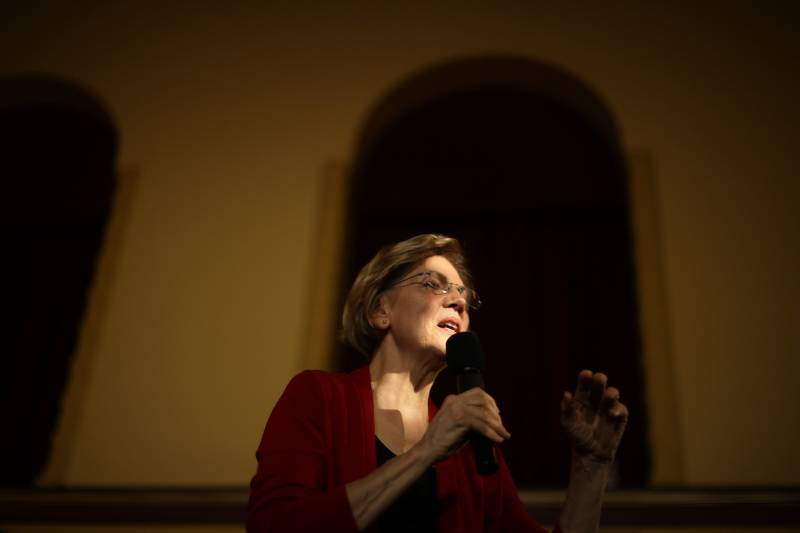‘Before the 2008 crash, investors and the government failed to address growing risks in our financial system. We’re making the same mistake with climate change today — we know it’s coming, but we’re not doing enough to stop it.’
—Elizabeth Warren, September 2018
Elizabeth Warren Climate Profile: Taking Up Mantle of 'Climate Candidate' Inslee

Been There
Sen. Elizabeth Warren, who represents Massachusetts, a state with strong ties to Puerto Rico, paid attention to Hurricane Maria when it spread death and lasting destruction across Puerto Rico in 2017. Warren was already fighting for debt relief for the territory before the storm. Maria brought the island’s plight into a climate focus. “There are people who have no food, there are people who have no water, there are people who have no medicine, there are people who need our help,” she said. “This is the responsibility of our government, the government that is supposed to work for us.”
Done That
Warren came to political prominence in her detailed response to the financial crisis of 2008, and that has carried over into her increasingly developed position on climate change. Look at the Climate Risk Disclosure Act that she introduced in September that would require companies to disclose the risk climate change poses to their financial assets. The bill would require companies to release information on their greenhouse gas emissions, fossil fuel holdings and how they would be impacted by both climate policies and the effects of climate change. The bill languished, but the issue has been gaining traction among fossil fuel company shareholders in recent years and appears to also be gaining traction among other candidates.
Getting Specific
• If Warren’s campaign had a single slogan, it would be “I have a plan for that.” While she entered the race with a reputation based on issues other than climate change — some environmentalists dismissed her leadership in this realm — she has made up for it with a series of expansive and fairly detailed prescriptions.
• Warren sought to pick up the baton of climate leadership from Washington Gov. Jay Inslee after he ended his climate-focused run for president. She met privately with him and then adopted his aggressive multipart action proposal. She has challenged all of the presidential candidates to make the same commitment to 100 percent clean energy, buildings and transportation. Warren’s plan calls for all new buildings to be zero-emissions by 2028, all electricity to be carbon-neutral by 2030, and all new passenger cars, trucks and buses to be zero emissions by 2030.
• Warren struck early with a pledge in April to prohibit all new fossil fuel leases on public lands. She had co-sponsored legislation on the same theme, but it never moved in the Republican Senate. Some, but not all, of the other candidates quickly echoed the promise.
• Warren’s opening climate gambit was a $2 trillion package of investment in green research, manufacturing and exporting, all to help “achieve the ambitious targets of the Green New Deal” over the next 10 years. She then raised that to $3 trillion, matching Inslee’s commitment, and explained exactly where the funds would come from: reversing the Trump tax cuts of 2017.
• Her plan would include $1.5 trillion for American-made clean energy products, $400 billion in funding for green research and development and $100 billion in foreign assistance to purchase emissions-free American energy technology. In her plan for environmental justice, Warren said she would direct one-third of her proposed climate investments or “at least $1 trillion” to vulnerable communities most impacted by climate change.
• Warren’s agriculture plan aims to incentivize farmers to invest in sustainable farming practices that reduce carbon emissions. It calls for expanding the voluntary Conservation Stewardship Program, which compensates farmers for implementing more sustainable practices, from $1 billion to $15 billion annually. Her platform also takes aim at breaking up the megamergers of agricultural corporations.
• Her “Blue New Deal” plan for the oceans would fast-track permitting for offshore wind energy while phasing out offshore drilling for oil and gas. Warren’s plan calls for electrification of ports to reduce local air pollution and greenhouse gas emissions. It also includes a “blue carbon” program that would support natural, ocean-based carbon sequestration projects including those involving coral reefs, mangroves, seagrass beds and wetlands.
ICN’s Take
Warren built her career in the Senate railing against Wall Street and championing consumer protection and economic equality. But her priorities are evolving as environmental and economic impacts of climate change increasingly merge.
On the campaign trail, Warren is increasingly taking a leadership role on climate issues — as when she became one of the first presidential candidates to sign the No Fossil Fuel pledge. When she released a detailed policy proposal in April to ban new oil and gas leases on federal lands and waters, other candidates quickly followed suit. And when Joe Biden put out a big climate pledge, Warren was able to quickly trump him with an even bigger commitment of her own. By aligning herself with Inslee’s climate ideas, Warren clearly is making a bid for climate voters.
Read Elizabeth Warren’s climate platform.
InsideClimate News is a nonprofit, independent news organization that covers climate, energy and the environment. Sign up for the ICN newsletter here.